http://antwrp.gsfc.nasa.gov/apod/ap070628.html
Wow. Last week Joe Cottral and I videotaped a pass of the ISS and the Shuttle from Ryerson Observatory; a quick look at the tape showed some structure to the brillant object we were trying to track; but I think I blurred from moving the telescope even the video sub-fields. On the tiny LCD monitor I think we could see the solar panels as two distinct lines separate from the main blob. I'll need to download the video.
But man, look at that image! Ron Dantowitz has been doing this for over ten years; and only gets better with time. Images like this always seem to perk the interest of the national imaging community.
Also see Mike Tyrrell's images (and videos mentioned here),
public Russian adaptive-optic images, the down-sampled Maui ones, etc.
Thursday, June 28, 2007
Earth and Jupiter from Mars
An older image, but cool nonetheless. Earth and Jupiter visible from Mars, taken by the now-deceased Mars Global Surveyor. Make sure you see the orbital diagram.
You have the chance to see Saturn and Venus close together, from right here on Earth, on Saturday evening, the same evening as the Full Moon.
You have the chance to see Saturn and Venus close together, from right here on Earth, on Saturday evening, the same evening as the Full Moon.
Wednesday, June 20, 2007
One more good ISS pass in Chicago
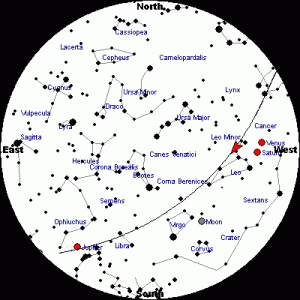
The last good pass of the International Space Station for Chicago in the near future will be tomorrow, June 22nd. You may be asking, why is that? To see the space station pass, you have to pass several criteria, each of which can derail easy viewing.
To first order:
1. The satellite must be above your local horizon.
2. The satellite must be sunlit while you are not.
On #1, a satellite's orbit around the Earth is a invariate thing--that is, it orbits the Earth and the ellipse it defines stays the same in an absolute reference. The Earth may rotate below it, but the object stays in the same fixed plane. Since the Earth rotates every 24 hours, you will roughly be under where the satellite orbits twice a day. The satellite also needs to be in the part of the orbit near you. Generally, this is not a problem, because 1. low earth orbit satellites have an orbital period of only 90 minutes and 2. you can see them several hundred miles away from their ground track. See this Java applet to see the Shuttle's visible ground track.
You also need the pass to occur when the satellite is lit by the sun, and have it dark where you are. This leads to satellites generally being most visible just after evening twilight and before dawn. In the summer, sunlight streaming over the pole can illuminate satellites for most of the night--many people remember staying up and watching the Perseids and seeing more satellites than meteors.
But because the satellite's orbit is fixed in space, and the Earth rotates around the Sun, at any one location the visibility factors come in and out of phase. The satellite's orbit hasn't really changed, but where the terminator is on Earth has. And tonight's ISS pass is the last good one for a few weeks.
So tomorrow, if it's clear, at 8:58 the ISS will start becoming visible in the WNW; pass well above Venus in the west; pass well above the moon, and reach a maximum altitude of 54 degrees at 9:01PM in the SW, and pass by Jupiter at 9:04PM in the SE.
Details at Heavens-Above
Animation and images of ISS and Shuttle pass in Chicago
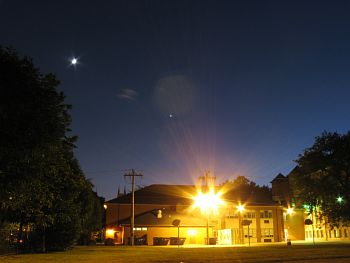
A fine night in Chicago, the Moon near Regulus, with Saturn halfway between the Moon and Venus.
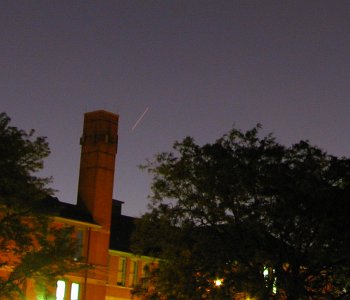
Space Shuttle Atlantis and the International Space Station passed Chicago last night. Rising in the NW, the newly brightened ISS shone orange against the Chicago light pollution, its solar panels dominating the light. In binoculars the Shuttle was visible trailing by half a degree. As they got higher, the Shuttle became visible to the naked eye and the ISS changed color into a pure white.
Check out this awesome animation of the pass:
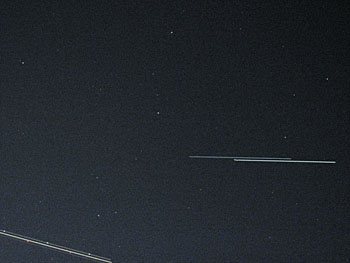
A single image of that animation is here, with an additional airplane trail.
See them tonight as well.
See the Shuttle and ISS again tonight, Wednesday, in Chicago
Last night was a fantastic pass--photos will be up in the next post. Tonight, see them again, this time starting at 9:52:07PM in the NW, reaching up about halfway to the zenith in the SW at 9:54:54PM, and entering the Earth's shadow a minute later.
Pass details from Heavens Above.
They look like a moving bright star--about as bright as Jupiter, which is low in the southeastern sky, but not quite as bright as Venus, which is in the west.
Pass details from Heavens Above.
They look like a moving bright star--about as bright as Jupiter, which is low in the southeastern sky, but not quite as bright as Venus, which is in the west.
Tuesday, June 19, 2007
See the ISS and the Shuttle TONIGHT in Chicago
See the two race across the sky, TONIGHT, Tuesday night, starting at 9:31:27 at 10 degrees above the NW horizon, reaching 54 degrees above the horizon to the NNE at 9:24:12PM, entering the Earth's shadow at 9:36:24PM, 16 degrees above the horizon to the ESE.
Predictions from Heavens Above.
Predictions from Heavens Above.
Monday, June 18, 2007
Friday, June 15, 2007
Online Geiger counter: off
The online Geiger counter is temporarily off while I deal with power issues in my office. I've also been thinking of taking it and a GPS on a tour around campus--there are a few places with exotic granites/other intrusives (like the Henry Moore sculpture not a few hundred feet away from my very desk) that have decent Uranium/Thorium concentrations.
Description of the counter
Description of the counter
Sunday, June 10, 2007
Nevada Solar One
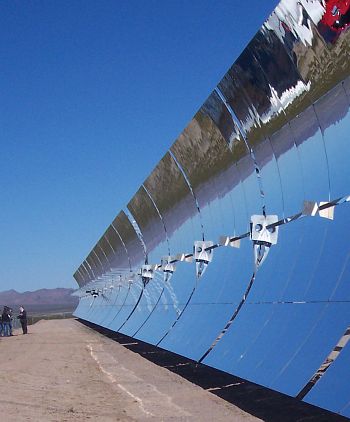
image from Solargenix
A large solar thermal energy plant is now online in the Eldorado Valley, just south of Las Vegas, creating up to 64MW of power from a 400 acre site covered with reflective troughs and tubes filled with brine (I was tempted to write "a series of tubes"). Molten salt is used to retain excess energy for later release when it freezes back into a solid. A view of the under construction site is here. The site is located conveniently next to a very large power distribution network hub.
The heated tubes are interesting in their own right. Schott makes them--a vacuum insulated glass tube with a blackened steel tube in the center. The outside has an anti-reflection coating, and the steel coating is made to reduce IR thermal emission: visible and near-IR go in, steel heats up, but it can't radiate thermal IR out. The result is 95% of light is absorbed; but only 14% of the IR is emitted. Keeping everything sealed at temperatures between freezing and 750F is difficult, and one of things Schott did was make a special glass with a coefficient of expansion the same as steel.
The second major solar energy project in southern Nevada is a 15MW plant at Nellis Air Force Base, using photovoltaic cells directly creating electricity. The system will track the sun, and it sits conveniently on an old landfill, land previously unusable.
In addition to these two major projects, there is a little over 3MW of solar energy projects in southern Nevada, with most of the total from the Las Vegas Valley Water District. See the status of Nevada energy projects in this 2007 report
Renewable decentralized solar energy continues to have arbitrary limits placed on it by law, keeping power companies monopolies in place. How requiring power companies to produce 15% of their power from renewables in eight years while disallowing much locally-produced power sources works together is beyond me.
From Friday's Las Vegas Review-Journal:
A lobbyist for the Clark County School District said she was pleased that the proposal increased the maximum amount of solar power the district can generate to 2 megawatts compared to 570 kilowatts. ...
But per school limits are 50 kilowatts.
Conklin liked that limitation, because it encourages the district to install solar plants at more schools, giving more students an opportunity to see how solar power works.
... Under the bill, customers may qualify for net metering if they generate as much as 100 kilowatts on their site, up from 30 kilowatts.
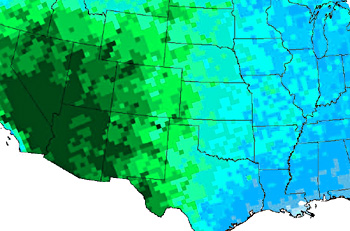
Nevada Solar One is static--a cheap low-maintenance support structure that resists wind damage very well (EDIT: someone corrected me: it's a one-axis tracker). The Nellis project uses tracking systems to maximize the solar gain. What is that gain? It depends a lot: on how much Sun you get, how long your days are, and how cloudy it is over the year. In Las Vegas, for instance, the overall solar energy received with a tracking system is about 7.1kWh per square meter per day averaged over the year. A static mount would get 6-6.5kWh. It doesn't sound like a lot of difference, but that's a per day number for only a square meter: multiply by 365 and for the size of the project, and it adds up. For single sunny months, tracking wins by far--over 9kWh per day in June in Vegas compared with 7 for a static system. It's interesting to note the incredible values created on the North Slope of Alaska--nearly as much as the desert Southwest--merely from having the Sun around for 24 hours a day.
Why aren't we doing more to power the cities of the Southwest with solar? Even just using solar water heaters in the warm months and smart skylights for daytime lighting would change energy use forever there.
A video describing Nevada Solar One, including some interviews, is available here.
And finally,
click here for a more amusing video about the 360MW of solar energy projects in California.
Thursday, June 07, 2007
The digital TV transition
In about a year and a half, analog broadcast TV will be ending and the transition to digital broadcast in the US will be complete. The New York Times carries an erroneous article about the transition, claiming "The V-shaped rabbit ears ... risk going the way of the eight-track tape player" because of the transition.
That's complete rubbish -- antenna use will increase, not go away (as some cable companies might claim), as people see huge quality improvements and the allure of free HDTV over-the-air. Instead of paying extra in order to get HDTV channels from Comcast, they'll re-discover the broadcast networks in HD, for free.
Some may argue the argument was for the VHF rabbit ears to go away, not the antenna in entirety, but they failed to note that at least here in Chicago, a major network (WBBM-DTV) broadcasts their HD signal on channel 3, in the low-VHF band, absolutely requiring the use of the so-called "obsolete" rabbit ears. See a long discussion about the HDTV situation here.
That's complete rubbish -- antenna use will increase, not go away (as some cable companies might claim), as people see huge quality improvements and the allure of free HDTV over-the-air. Instead of paying extra in order to get HDTV channels from Comcast, they'll re-discover the broadcast networks in HD, for free.
Some may argue the argument was for the VHF rabbit ears to go away, not the antenna in entirety, but they failed to note that at least here in Chicago, a major network (WBBM-DTV) broadcasts their HD signal on channel 3, in the low-VHF band, absolutely requiring the use of the so-called "obsolete" rabbit ears. See a long discussion about the HDTV situation here.
Monday, June 04, 2007
Shuttle launch on June 8th
The upcoming Shuttle mission starting on Friday evening is a big construction project on the ISS, to move and add a large solar array to the station. The ISS currently looks a little lopsided; here's an image from December 2006:
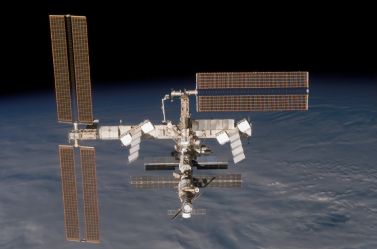
Here's an artist's rendition of the planned work; you can see the second pair of solar arrays added. They are removing the odd array on the top; one thing I couldn't tell from the press release was whether they are storing it up there and redeploying it at a later date or bringing it back; the full ISS would have eight solar panels on each side.
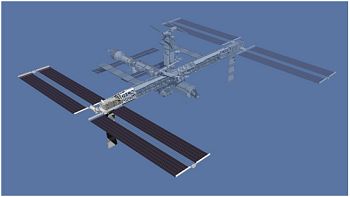
I picked this image up from the STS-117 Press Kit

Here's an artist's rendition of the planned work; you can see the second pair of solar arrays added. They are removing the odd array on the top; one thing I couldn't tell from the press release was whether they are storing it up there and redeploying it at a later date or bringing it back; the full ISS would have eight solar panels on each side.

I picked this image up from the STS-117 Press Kit
Friday, June 01, 2007
Some useful astronomy charts
For the current Mercury and Venus evening apparitions, here are two useful graphics from Curt Renz, plus the lunar phases for June:
June moon calendar
Mercury evening apparition
Venus evening apparition
See via Chicago Astronomer's forum
June moon calendar
Mercury evening apparition
Venus evening apparition
See via Chicago Astronomer's forum
Subscribe to:
Posts (Atom)
